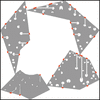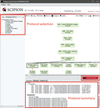issue contents
June 2022 issue

Cover illustration: Assalauova et al. [J. Appl. Cryst. (2022), 55, 444–454] report application of a convolutional neural network for the single-hit diffraction-pattern classification step in single-particle-imaging experiments at X-ray free-electron lasers.
research papers
Open  access
access
 access
accessA convolutional neural network is applied for the single-hit diffraction-pattern classification step in single-particle-imaging experiments at X-ray free-electron lasers. This approach can be employed not only after the experiment but, importantly, also during an experiment and can significantly reduce the size of data storage for further analysis stages.
Open  access
access
 access
accessThe errors for particle sizes obtained by integral-breadth- and Fourier-decomposition-based techniques depend on the shape of the diffracting domains.
The effects of solvent on the morphology of ammonium dinitramide are studied experimentally and by molecular dynamics simulation.
Open  access
access
 access
accessThis work shows how spatiotemporal redundancy can overcome the twin-image stagnation mode in coherent diffractive imaging, and explores the relationship between detector frame rate and signal-to-noise ratio in the application of imaging nanoscale dynamic behaviour at kHz frame rates.
Download citation


Download citation


The morphology and structure of (NixMg1−x)3Si2O5(OH)4 synthetic phyllosilicate nanoscrolls are studied by means of electron microscopy and X-ray powder diffraction. Unit-cell parameters, microstrain and crystallite sizes are determined.
Open  access
access
 access
accessThis paper describes the design and implementation of an in-house laboratory powder X-ray diffractometer tailored for structural investigations of energy materials. The performance characteristics of the diffractometer together with some example research applications are presented.
An application of formal verification by theorem proving in Isabelle/HOL to ensure the correctness of a space-group-derivation algorithm is presented.
Oxygen crystallographic positions in thin films by non-destructive resonant elastic X-ray scattering
A nondestructive approach based on resonant elastic X-ray scattering in the extended X-ray absorption fine structure domain is used to locate oxygen atoms in nanosized functional oxides. The method is first validated on a bulk sample and then applied to a thin film.
Open  access
access
 access
accessBin widths for histograms of inelastic neutron scattering (INS) spectra are optimized for a given data set and inferred for other data sets of different total counts. After verification of the results on INS experimental and simulated data sets, utilization of the method and further improvement are discussed.
Minute lattice misorientation away from the dislocation core was revealed in rocking curve topography as the angular resolution was significantly increased. The contrast of the dislocation images can be calculated using ray-tracing simulations
Open  access
access
 access
accessA software-control system has been developed that enables access to site-selective energy-dispersive X-ray spectroscopy/electron energy-loss spectroscopy measurements from a sub-micrometre area by automatically and concurrently tilting the beam and acquiring spectra.
High-resolution X-ray diffraction in an Si wafer with vertical Al-doped micrometre-wide channels was studied experimentally and theoretically. The calculated reciprocal space maps of the channel and near it corroborate the experimentally obtained ones and prove their high sensitivity to structural distortions, as well as the possibility of retrieving the impurity concentration in the channel in the Bragg geometry.
Open  access
access
 access
accessBased on the continuum theory of micromagnetics, theoretical expressions for the polarization of the scattered neutron beam in uniaxial small-angle neutron scattering have been derived and their predictions tested by analyzing experimental data on a soft magnetic nanocrystalline alloy. The here-presented theoretical framework forms the basis for polarized real-space methods such as spin-echo small-angle neutron scattering, spin-echo modulated small-angle neutron scattering and polarized neutron dark-field contrast imaging.
Open  access
access
 access
accessThree different approaches are compared for determination of the correlation function from the small-angle neutron scattering data of a powder sample of iron oxide nanoparticles.
Open  access
access
 access
accessMacroscopic spin-misalignment small-angle neutron scattering cross sections and response functions are computed analytically for a material with global uniaxial magnetic anisotropy (texture). The resulting expressions are tested against previously published experimental data.
Open  access
access
 access
accessIn this article, an image-analysis-based method is applied to electron backscatter diffraction (EBSD) data in order to recover specific properties in a complex microstructure, and some new dedicated tools are developed and compared with existing methods.
short communications
The porosity and the specific surface of a porous material can be determined by its powder ultra-small- (USAXS) and small-angle X-ray scattering (SAXS) intensity when the Porod plot shows two plateaux.
Changing the crystal structure of scintillation materials changes the valence-band electron density, which enhances the efficiency of scintillation detectors. This will enhance the image quality of all imaging techniques based upon scintillation detectors.
Open  access
access
 access
accessThis work demonstrates three-dimensional Bragg coherent diffraction imaging of single 20 nm Pt particles at the ID01-EBS beamline of ESRF.
Through this work, it has been shown that, without additional retraining, the convolutional neural network model on space group predictions performs with reasonable accuracy even on input atomic pair distribution functions with a relatively wide range of experimental parameters, and can thus be used as a robust computational tool.
CIF applications
Open  access
access
 access
accessA program is described for visualizing powder diffraction data and models published in powder CIF format.
computer programs
Open  access
access
 access
accessThe design and usage of Scipion-ED, a graphical user interface program for processing and analysis of three-dimensional electron diffraction (3D ED)/microcrystal electron diffraction (MicroED) data, are presented. A study of the influence of data merging strategies on the ability to resolve unmodelled features of tetragonal lysozyme is included as an illustration of the advantages of Scipion-ED.
Download citation


Download citation


Open  access
access
 access
accessIterative optimization of the unit-cell parameters improves the refinement of organic small-molecule structures using electron diffraction data.
Open  access
access
 access
accessDISEMM is a software tool to analyse neutron or X-ray diffraction data on polycrystalline samples collected under mechanical load, combining the determination of single-crystal elastic constants and the methods of elasto-plastic self-consistent modelling in one package.
A computer program with a graphical interface, named Model2SAS, was developed for the calculation of small-angle scattering curves from custom three-dimensional shapes and scattering length density distributions supplied in an STL file or as a mathematical description.
UnitCell Tools—Two Patterns is a robust program that can reconstruct the 3D reciprocal cell, perform Niggli reduction and determine lattice parameters based on the two-pattern method (the HOLZ-based method and the angle-based method).
Open  access
access
 access
accessThe open-source software SAXSDOG performs a real-time azimuthal integration of 2D scattering images reaching peak integration performance at current hardware limits.
laboratory notes
Open  access
access
 access
accessA method to separate sample preparation from X-ray diffraction and powder X-ray diffraction measurements is presented. The necessary equipment is accessible at low cost by 3D printing.


 journal menu
journal menu















































